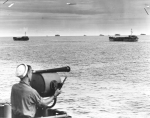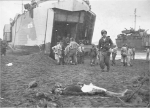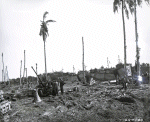Click On Image
For Full Size Image |
Size |
Image Description |
Contributed
By |

1016006622 |
327k |
A Signalman sends a blinker signal from USS LST-66 to USS LST-270
during the Hollandia operation in April 1944
US National Archives Identifier 205585004, Local ID 26-G-2216, US Coast Guard photo # 2216 by Sturges. |
David Upton |
 |
36k |
USS LST-270 beached at Aitape, North East New Guinea, 22 April 1944 while discharging heavy equipment for RAAF Works, Survey and Signals Units during the assault on Korako Village. The dead Japanese lies on the sandy beach mute testimony of ineffective resistance. |
Glen Carlson SM/1c USS LST-270 |

1016048607 |
10,728k |
From right to left;
USS LST-269,
USS LST-486,
USS LST-270,
USS LST-704 and
USS LST-117
and three unidentified LSTs (all of LST Flotilla Three) spread along
(from the left) Orange Two, Orange One, Blue Two, Blue One beaches of the initial landings on Leyte Island,
Philippines. The date is 21 October 1944 between 0914 and 1051 hours. Within the next few hours the Japanese would
rain down mortar and artillery fire onto these beaches.hitting LST-486 on main deck between frames 14 and 15, no
casualties; LST-269 received two direct mortar hits killing two and wounding three; LST-704 received seven direct hits
by mortar and artillery causing much damage and killing two, and wounding twenty-three with two dying later.
Ref. LST-704 War Diary and COMLSTFLOT3 War Diary, U.S. Army Signal Corps Photo 254880 now in the collections of the US National Archives,
Local ID 111-SCA-2857. National Archives ID 80662621. |
David Upton |


